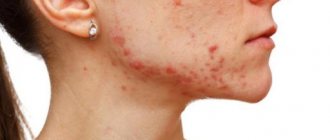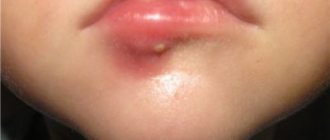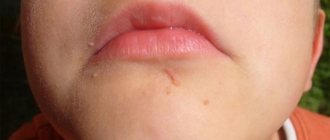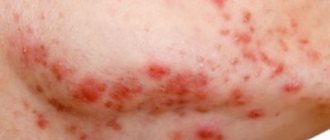The infectious disease chickenpox manifests itself as a rash in the form of blisters on the face and body. Some people underestimate the severity of smallpox, believing that only young children are affected. However, in the absence of immunity to this infection, adolescents and adults can get sick, and in a more severe form than preschoolers.
All patients are interested in how long chickenpox rashes last in children and adults. After all, it is the rash that causes the most concern for patients of any age.
When does chickenpox appear after infection?
Chickenpox is predominantly a childhood disease, which is diagnosed in young patients aged 2-7 years. However, an adult can also become infected if he did not get sick in childhood.
Chickenpox is transmitted from a sick person through airborne droplets during sneezing and coughing. Some believe that you can become infected through household items or through third parties, but in reality the risk is zero. The pathogen lives in the environment for no more than 15 minutes.
From the moment of infection to the appearance of the first symptoms, a certain period passes - the incubation period. At this time, the virus penetrates the cellular level, becomes active and multiplies.
When asked how long it takes for chickenpox to appear, we can name an average time of 10-21 days, the variability of which is determined by the age of the patient, the state of the immune system, and the concentration of viral substances that entered the body during contact with an infected person.
Duration of incubation period depending on age:
- For children – 14 days;
- In adults under 30 years of age – 13-17 days;
- In adults over 30 years old – 11-21 days.
Rashes on the child’s skin should be looked for 11-14 days from the moment of probable infection. If no symptoms appear within three weeks, infection can be ruled out.
Interesting: until the 17th century, chickenpox was equated with a deadly disease - it was considered a type of smallpox. Only in 1772 was the disease identified as a separate pathology, and the virus was studied in the mid-twentieth century.
How to smear inflammation so that there are no traces left later?
An effective method is to use a dark purple solution of potassium permanganate, a solution of brilliant green or iodine, which can be used to spot pimples. These remedies are considered the most effective and promote a speedy recovery and prevent further infection of the skin. The child may experience itching that does not go away for a long time and causes discomfort to the baby. In this case, you need to consult a doctor who can prescribe a medication that can reduce inflammation on the skin.
During the treatment period, it is worth limiting the patient from drinking large amounts of liquid, which provokes suppuration of small rashes. During bed rest, physical activity is contraindicated!
If we talk about folk methods of relieving itching, the most common is a decoction of chamomile and string, which should be used to wash the child. The decoction can be used several times a day, because it does not cause allergies. Sometimes doctors also prescribe homeopathic medications, but such cases are really rare, because such supplements require additional testing of the child’s body for predisposition to certain substances. If severe itching occurs, medicinal ointments and gels can be applied to areas of the skin to reduce discomfort.
When do chickenpox rashes appear?
During the incubation period, the herpes virus type 3 penetrates to the cellular level through the mucous membrane of the respiratory tract. It spreads throughout the body and multiplies rapidly. To answer the question of when chickenpox appears, you need to consider the stages of the incubation period:
- Initial. It is characterized by penetration through the mucous membrane of the respiratory organs.
- The development of the incubation period is an adaptation stage, which is characterized by the accumulation of viral particles in the affected epithelial cells. It then spreads through the lymphatic system, moving into the blood.
- The final stage is accompanied by the release of the virus and spread throughout the body. The pathogen accumulates in the skin and causes the formation of a characteristic rash.
After the incubation period, a prodromal stage is observed. It is accompanied by general malaise, headache, body aches, fever and other symptoms. They may be absent if chickenpox is mild. Two days later, a rash appears; then there is a period of wave-like rashes, crusts form.
Preparing for HSV analysis and deciphering it
Important: chickenpox is contagious 1-2 days before the rash appears, the entire period of the rash, and also 5 days after the last blister appears.
Prevention
Because the virus spreads through the air, chickenpox is difficult to avoid. Therefore, the most reliable method is vaccination. If infection has already occurred, then in order to avoid complications and the progression of a mild form of pathology to a purulent one, it is necessary to carefully monitor hygiene.
Be sure to keep your body clean. The patient is recommended to take a shower twice a day, change his underwear and bed linen daily, which subsequently will not be superfluous to boil. Nails should be cut short. It is recommended to lubricate the crusts left after bursting blisters with Syntomycin emulsion, which has a powerful antimicrobial effect. It is recommended to wipe blisters on the mucous membranes with a decoction of chamomile or string.
- How to get rid of scars after chickenpox?
General symptoms in children and adults
The symptoms of chickenpox in clinical pictures are different. Children usually tolerate the disease more easily than adults. During the prodromal period, the following clinical manifestations are observed.
- Fever. A sharp increase in temperature during the day. It can decrease on its own and then increase again. The rise is noted at the time of rashes on the body. Lasts for 2-4 days. If the rash is profuse - up to 9 days. In childhood, the temperature may increase slightly or remain at a normal level;
- Manifestations of general intoxication. Weakness, lethargy, apathy, migraine, pain in the lumbar region, loss of appetite, attacks of nausea and vomiting. Symptoms are more pronounced in adults; in children they are absent or mild.
The clinical manifestations of chickenpox depend on the form of the disease. It can be light, medium and heavy. In childhood, mild is most often observed; in adult patients, moderate and severe are diagnosed.
Approximately on the second day of the described symptoms, rashes appear. The duration of this period ranges from 2 to 9 days. The next period is the formation of crusts - blisters become covered with them on the 5th day after appearance.
Treatment
Itching with chickenpox is the main concern for the child and a lot of trouble for the parents, and adults also suffer greatly from the unbearable desire to scratch the rash. There is no specific treatment for the infection. Treatment is to relieve symptoms. For this purpose, antiviral and antihistamine external agents are used. External means:
- The most commonly prescribed ointment is Acyclovir (Zovirax) . The active substance of the drug penetrates under the epidermis, where it blocks the reproduction of the virus. As a result, skin inflammation goes away faster and the patient recovers faster. The ointment has antipruritic properties. Apply the product to papules 4-5 times a day.
- For chickenpox, Gossypol cream, which has an antiviral effect, is also used.
- An analogue of Gossypol in action is Flacozid cream. It is used for chickenpox and herpes on the lips. The product is used to lubricate acne 5 times a day for 5 days.
- The antihistamine drug Fenistil gel is very effective for chickenpox. The drug relieves painful itching, as a result of which the child calms down and falls asleep at night.
- You can treat the vesicles with a cosmetic product - Calamine lotion. It is applied to acne 7 times a day for 5 days. If the rash still itches, the course of treatment is continued until the itching stops.
- Tsindol, a zinc-based suspension, is used for smallpox.
Treatment of the rash is carried out from the onset of the disease and continues for a week.
Chickenpox rash: stages and localization
Herpes of the third type is localized in the epidermis, as a result of which vacuoles appear in the affected cells, merging with the vacuoles of neighboring cells. The resulting cavity quickly fills with liquid, which contains many viral particles. Over time, toxins, fibrins, and other substances accumulate in the contents of the papules, which leads to their ulceration outward. They burst and the contents spill out.
The chickenpox rash appears on the first or second day after the fever increases. During the period of a wave of rashes, it constantly increases, and the general well-being of the sick person worsens.
For your information, in childhood, a characteristic rash may be the first and only sign of chickenpox.
Stages of rash development:
Symptoms of herpes zoster during pregnancy and its treatment
- The appearance of red spots. They are round or oval in shape, the diameter varies from 5 to 10 mm. They quickly transform into pimples.
- The papule looks like a red nodule located in the center of the spot.
- Bubbles are pathological elements that rise above the skin; filled with exudate. The size varies widely from 1 mm to 1 cm. They are characterized by a very thin surface that easily bursts at the slightest pressure. In severe cases, they can fester, resulting in scars and cicatrices.
- Crusts are the final stage of the rash. They form at the site of merged blisters.
The chickenpox rash is localized in areas of the skin that have a good blood supply. The first rashes can be found on the neck, scalp and upper torso. Then the rashes appear chaotically.
The number of pathological elements depends on the form of viral pathology. In a mild form, the amount is single; the rash may not be noticed at all if it affects exclusively the scalp.
At the other extreme, the rash covers the entire surface of the skin. In medical practice, there have been cases when a patient had up to 800 papules.
Possible complications
The most likely complication of the disease is scars that form at the site of the rash. Other consequences of chickenpox develop mainly against the background of weakened immunity or with generalized damage to the body. Such complications include:
- abscess;
- phlegmon;
- pneumonia;
- laryngitis;
- stomatitis;
- eye diseases;
- damage to the central nervous system.
Purulent chickenpox develops when bacterial microflora is attached. The course of the disease is accompanied by the gradual death of skin tissue and the formation of large and often painful blisters. Chickenpox is treated with antibacterial and antiviral drugs.
Rash with atypical chickenpox
Anyone can get chickenpox; it is impossible to insure against the disease. After recovery, the patient acquires lifelong immunity to the virus, although the latter remains in the body forever, being in a latent state.
Under the influence of negative factors against the background of low immune status, frequent stress, neuroses, the virus is able to become more active, as a result of which secondary chickenpox is diagnosed. However, this is observed extremely rarely.
The varicella-zoster virus multiplies in the mucous membranes, resulting in changes in the structure of the epidermis. In severe cases, a rash develops on the mucous membrane.
Stages of occurrence of a rash on the mucous membrane:
- The appearance of red spots on the mucous membrane of the oral cavity and genitals. They are observed on the palate, conjunctiva of the organs of vision, gums;
- The appearance of bubbles filled with transparent contents. The mucous membrane becomes softer, they quickly burst;
- The development of afts is small ulcers covered with a white or yellow coating consisting of fibrin. They have a red border and there is an inflammatory process. It hurts the patient to eat, talk, swallow, etc. If pathological elements are observed on the genitals, then there is severe discomfort and severe itching.
In addition to damage to the mucous membranes, multiple rashes are observed throughout the skin.
Worth knowing: the atypical form is mostly diagnosed in adult patients with immunodeficiency, chronic diseases, and exhaustion.
Causes of ulcers
A severe form of chickenpox is always accompanied by pustules that appear on the skin after a secondary infection has occurred. The usual form of chickenpox progresses to a severe stage for a number of reasons. First of all, this happens if the doctor’s instructions are not followed, if the patient scratches the rashes and tears off the resulting crusts. Damaged pimples become the main cause of infection by pathogenic bacteria. The infection spreads quickly between other lesions. Gradually they all begin to fester and hurt.
The main cause of chickenpox rashes is the bacteria staphylococcus and streptococcus. Therefore, ulcers with chickenpox in adults are treated only with a course of antibiotics.
Features of skin rashes
False polymorphism is characterized by the fact that in one area of the skin pathological elements at different stages of development are simultaneously detected - crusts, papules, blisters, red spots. This is due to the fact that the rash appears unevenly, but in waves.
Practice shows that during chickenpox, about 3 waves of rashes occur. Each subsequent one is accompanied by the appearance of fewer bubbles. The rash never appears on the palms and soles.
After the crust falls off, a pigment spot remains, which differs in color from healthy skin. Within 2-3 months it fades and disappears. The rashes do not leave scars, scars, or other skin defects if they are not injured. It is easier to get chickenpox in “the right time” - in childhood, which allows you to avoid a severe course and complications. If a child has good immunity, he will overcome the disease easily.











